Science and Engineering Complex Wins Board of Trustees Approval

A proposed look for the 22nd Street façade of the newly-approved Science and Engineering Complex.
Ballinger
The GW Board of Trustees has given the university the green light to build the proposed state-of-the-art Science and Engineering Complex on the Foggy
Bottom Campus.
The board unanimously approved the project in October after reviewing design and cost estimates, and hearing from university leaders about the impact the complex would have on learning, research, and recruitment.
Construction is anticipated to begin in 2011 and be completed in late 2014, with occupancy expected in early 2015. The planning for this project has been underway since 2006.
"The board fully supports the mission of the Science and Engineering Complex and recognizes that it will transform GW and help us strengthen our reputation as a premier research institution in the nation's capital," says Chairman of the Board of Trustees W. Russell Ramsey, BBA '81. "It will be a powerful magnet for world-class faculty and students, and provide state-of-the-art yet flexible learning and research space for them to work collaboratively with corporate and government partners."
The eight-story building will nearly double the amount of space currently available at GW for science and engineering. The complex will include approximately 400,000 square feet above grade and yield 290,000 square feet of assignable space for teaching and research laboratories for GW's Columbian College of Arts and Sciences and the School of Engineering and Applied Science.
The School of Medicine and Health Sciences and collaborators throughout the university also will be involved in research in the building.
A typical floor in the proposed new complex will include research and teaching areas as well as faculty offices and breakout spaces.
"The board's decision to build the Science and Engineering Complex marks an important milestone in the development of George Washington into a world-class research university," GW President Steven Knapp says. "This crucial addition to our academic facilities will open countless new opportunities for learning and research, to the benefit of students and faculty in a very wide range of fields."
The building, which will be located on the site of the current University Parking Garage at 22nd and H streets, will feature two levels of below-ground program space, approximately 350 underground parking spaces, and a retail venue on the ground floor along Eye Street.
Sustainability is a critical component of the programming and design for the complex, and the building will be constructed in accordance with the U.S. Green Building Council's Leadership in Energy and Environmental Design standards, targeting silver certification or higher.
The estimated cost of the facility is $275 million, which will be paid for through endowment payout from the Square 54 ground lease payments, indirect cost reimbursement for grants and contracts supporting faculty research, and donor gifts.
"One of the benefits of starting the construction process now is that we can take advantage of building this complex when construction costs are lower due to market conditions," Executive Vice President and Treasurer Lou Katz says.
The university's project team includes Ballinger Architects/Hickok Cole Architects, Boston Properties as the project manager, and Clark Construction for pre-construction services. Input from faculty, students, and alumni also has been an integral part of the building planning process.
New Brain Trust Launched as Hub for Neuroscience Research
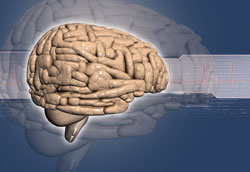 Probing deeper into the mysteries of the brain—how it's built, how it works as a cohesive unit, and how that gets distorted by disease—will be the work of the university's new Institute for Neuroscience, which launched over the summer.
Probing deeper into the mysteries of the brain—how it's built, how it works as a cohesive unit, and how that gets distorted by disease—will be the work of the university's new Institute for Neuroscience, which launched over the summer.
The institute is led by Anthony-Samuel LaMantia, an internationally renowned researcher formerly at the University of North Carolina at Chapel Hill, and is housed in the School of Medicine and Health Sciences.
It will serve as a hub for neuroscience research among GW faculty, post-doctoral fellows, and students at the Foggy Bottom Campus, and researchers at Children's National Medical Center.
"I think it is really remarkable that GW, in a time when many academic institutions are retrenching, is committing to developing new research enterprises," Dr. LaMantia says.
"I hope that we can build the sort of community of neuroscientists that stimulates important new research in what I believe to be one of the most exciting and essential biomedical research issues—how our brains work and how things can go wrong," he says.
By the fall, the institute had inaugurated a neuroscience seminar series jointly sponsored with the Center for Neuroscience Research at Children's National, featuring as its first speaker Thomas Insel, director of the National Institute of Mental Health.
The institute also was working to organize a new graduate course in the neurobiology of developmental disorders, and to establish a new facility—the Biomarkers Discovery and Analysis Core—to offer facilities and expertise in, among other things, identifying how and where genes are expressed in the developing and adult brain.
The institute also has established new facilities for studying neural stem cells and other cell lines, and for manipulating gene expression in nerve cells.
"These approaches have become essential tools in the effort to understand how the genome controls the way the brain develops and the way that nerve cells work," Dr. LaMantia says. These facilities will offer access to technologies that individual researchers wouldn't be able to set up in their own labs.
Recent advances in manipulating genes and linking them to specific brain functions have brought the field to an exciting juncture, he says. "We are at the same point in neuroscience as cancer biology was in the late 1970s, when the first oncogenes were identified and essential cell biological targets for cancer pathogenesis began to emerge.
"I would like to see GW neuroscientists continue to put together how the genome normally ensures that the brain gets built and operates optimally, and what are the key points where this process can go wrong," he says. "I think this effort will yield insight into the pathology of a whole range of now intractable diseases, from autism and other neurodevelopmental disorders—my own interests—through neurodegenerative diseases, like Alzheimer's."
The institute currently includes 24 faculty members, with plans for four more, and is jointly supported by the School of Medicine and Health Sciences, the Columbian College of Arts and Sciences, and the Office of the Vice President for Research.
Alumni, Faculty Win Fulbright Awards
From Vietnam to Argentina, and Russia to Jordan, emissaries of the university will be fanning out across the globe as students and scholars of the Fulbright Program during the 2010-11 academic year.
The prestigious U.S. State Department-sponsored program this year includes seven faculty members or administrators and 13 alumni. The university was recognized by the Chronicle of Higher Education as one of the nation's top producers of Fulbright students.
These faculty members and administrators have been named this year's Fulbright scholars:
Efstathia Bura, director of the biostatistics program and associate professor of statistics, will work on the project "Sufficient Dimension Reduction Moment Based Methods and Maximum Likelihood Estimation" this spring in Argentina.
Patrick Forrest, professorial lecturer in engineering, will conduct research at the University of Alberta in Edmonton, Canada. Beginning in January 2011, he will work on his project, "Protracted Refugee Situations: Improving the U.S. and Canadian Response to an Ongoing Crisis."
Dennis W. Johnson, professor of political management in the Graduate School of Political Management, has been awarded a Fulbright Distinguished Lectureship at Jinan University in Guangzhou, China. Dr. Johnson will teach courses on American domestic public policy and national political institutions, and will travel widely throughout China giving lectures on current American politics and policy.
Joel Kuipers, professor of anthropology and international affairs, will be in Yogyakarta on the Indonesian island of Java studying the role of language in everyday Islamic piety.
Donna Scarboro, associate vice president for international programs and professorial lecturer in English, completed a summer 2010 Fulbright International Education Administrators study trip to Japan, which included visits to Tokyo, Kyoto, and Hiroshima.
Marc St. Hilaire, coordinating adviser for GW's Center for Undergraduate Fellowships and Research, will travel to Germany to participate in the 2010 Fulbright Seminar for U.S. Administrators in International Education.
Steven Tuch, professor of sociology and of public policy and public administration, will work in Poland on the project "Stratification Ideologies in Postcommunist and Capitalist Nations: A Comparative Study of Poland and the United States, 1987‑2009."
A Day of Service
First lady and Animal Planet host participate in GW's second annual event
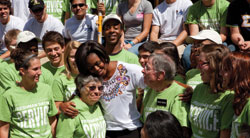
Mrs. Obama hugs a volunteer at the McLean, Va.-based Vinson Hall Retirement Community, where Mrs. Obama and members of the GW community painted a loading dock for the facility, which serves former military officers and their families.
William Atkins
On Sept. 11, freshman Hannah Bower worked on a service project at the Anacostia Watershed Society because, as a District resident, she said she wanted to help keep her new home clean.
"By volunteering our time and giving back to our community, we can hopefully start a ripple effect," she says.
In another part of the region, first lady Michelle Obama joined 150 GW students at the Vinson Hall Retirement Community, in McLean, Va., one of 14 sites where members of the GW community volunteered for GW's second annual Freshman Day of Service.
Work sites in all eight D.C. wards, Maryland, and Virginia drew more than 1,900 GW students who served in projects that included work with the Anacostia Watershed Society, in the National Park Service's Rock Creek Park, and at the Capital Area Food Bank.
At the retirement community, which serves former military officers and their families, Mrs. Obama worked with students and GW Provost Steven Lerman to paint a loading dock.
Animal Planet host Jeff Corwin kicked off the day with a speech in the Charles E. Smith Center about the importance of sustainability and conservation. Mr. Corwin shared stories of people around the world who are trying to save the planet and said their actions, and the service of GW students, show "the power of one."
Members of the faculty and staff also participated in the day of service. President Knapp and his wife, Diane, worked with students cleaning areas along the water in Rock Creek Park and sorting food at the Capital Area Food Bank.
The students who served with the Anacostia Watershed Society volunteered alongside George Hawkins, director of the D.C. Water and Sewer Authority, and Walter James, mayor of northeast suburb Bladensburg, Md., which sits along the Anacostia River.
The day concluded with a barbeque and a 9/11 candlelight vigil in Kogan Plaza.
To see photos and video highlights of the second annual Freshman Day of Service, including coverage of Mr. Corwin and Mrs. Obama's visits, go to http://gwtoday.gwu.edu/aroundcampus/adayofservice.
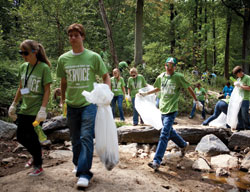
Students clean an area of Rock Creek Park.
Jessica McConnell
|
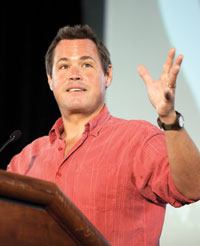
Animal Planet host Jeff Corwin speaks to the GW community in the Charles E. Smith Center to kick off the second annual Freshman Day of Service on Sept. 11.
Jessica McConnell
|
A Growing Problem
 Obese women: $4,879
Obese women: $4,879
Obese men: $2,646
Overweight women: $524
Overweight men: $432
The annual individual cost of obesity for women and men in the United States is rising, according to a September report by researchers in GW's Department of Health Policy. The figures actually represent only part of the cost; while health- and work-related costs are well-studied, the researchers found little literature on consumer-related costs, like clothing, air travel, and furniture. The costs were far lower for people who are overweight, rather than obese. Still, roughly two-thirds of Americans are overweight or obese; if the trend holds, the researchers said, half the population could be obese by 2030.
An Academic Veteran Retires
Vice President Don Lehman saw the university through four decades of steady improvements
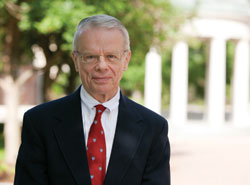
Jessica McConnell
When Donald R. Lehman, PhD '70, came to GW in 1965 as a part-time doctoral student, the Marvin Center did not exist, the library was divided between Lisner Hall and Stuart Hall, the Academic Center was a parking lot, a row of townhouses stood where Gelman Library is now located, and Funger Hall was named Building C.
"I cannot exaggerate what a transformation there has been," says Dr. Lehman, who stepped down this summer as executive vice president for academic affairs and chief academic officer and is officially retiring at the end of the year.
Since September, Dr. Lehman, the George Gamow Professor of Theoretical Physics, has been serving as a special adviser to President Steven Knapp, with a focus on gaining approval for construction of the Science and Engineering Complex. The building is one of many key projects for Dr. Lehman throughout his years as a GW administrator. Some of the biggest enhancements at GW for which he played major roles include GW's Strategic Plan for Academic Excellence, his involvement in selecting all the deans who are currently in place, enhancements to classroom technology, and establishment of the School of Nursing, among others.
Asked to reflect on his years at GW, Dr. Lehman reiterated several times how privileged he feels. "You don't dream about these sorts of things," he says of working in the central GW administration, which has helped him make friends across the university. "When you are in a department, your world is pretty small," he explains.
Dr. Lehman, who has taught thousands of students, says professors can greatly impact their students' lives in a way that sometimes can only be realized 25 years later. "You only start to think about it when one of the members of the board of trustees comes up to you and says, 'You probably don't remember me, but you taught me in engineering physics,'" he says of Nelson Carbonell Jr., BS '85, vice chair of the board, whom he taught in the early '80s. "Nelson can tell you some pretty funny stories about me."
As a program officer responsible for high-energy particle physics in the U.S. Air Force's Office of Scientific Research in the '60s, Dr. Lehman decided to pursue a doctorate at GW, because it allowed him to be a part-time PhD student. He was already writing his dissertation when he completed his military service, and he worked as a graduate teaching assistant at GW and then as an instructor.
After completing his degree, he took a position at the Bureau of Standards—now the National Institute of Standards and Technology. Then, in 1972, GW offered Dr. Lehman a position as an assistant professor of physics. Including his year and a half as an instructor, he will complete 40 years on the faculty at GW when he retires.
His retirement plans include catching up on physics reading so that he can return to his research. Further plans include spending summers with his wife in Maine sailing, hiking, kayaking, and taking photos. Elyse Brauch Lehman, MA '67, PhD '70, professor emeritus of psychology at George Mason University, retired in 2007. "She's been urging me to retire ever since," Dr. Lehman says.
The Lehmans also continue their association with GW through a $2 million bequest commitment to create the Elyse B. and Donald R. Lehman Endowed Professorship in Theoretical Physics to attract leading scholars and teachers and advance the study of theoretical physics.
A physicist through and through, Dr. Lehman seems to clearly understand his place in the bigger picture of higher education.
"We don't make widgets. We educate people, and we create new knowledge. That's a very special mission," Dr. Lehman says. "It's probably the most critical driver to maintaining the financial and economic well-being of the United States."
"I'm eternally optimistic about universities," he says, "because they are the lifeblood of this economy, this society, and what it means to be free."
—Menachem Wecker
Innovation Task Force Moves Forward on Top Six Proposals
After a year of groundwork, GW's Innovation Task Force moved into its second phase in September as it began developing plans to bring to reality the top six ideas generated so far by the GW community.
A steering committee, chaired by Jeffrey Lenn, associate vice president for academic operations, and two working groups—one for business processes and the other for learning/teaching—led the effort by generating, evaluating, and prioritizing more than 400 proposals aimed at enhancing GW's academic enterprise while creating significant savings or new revenue through improved operations.
The list was then winnowed to 15 and presented in April at a series of town hall-style meetings. President Steven Knapp and his council of senior administrators signed-off on the final set of first-round recommendations in June.
In this next phase, the ITF plans to develop six leading ideas every six months, moving forward on implementing one group while they vet the next batch of ideas.
Throughout phase two, new ideas for innovation will continue to be solicited from the GW community. (Submit an idea online at innovation.gwu.edu.)
The first set of ideas slated for implementation will save the university millions of dollars while strengthening the quality of the GW experience.
Savings and new revenue accrued toward the initiative's $60 million goal will be placed in the university's Innovation Fund—a separate entity from the general operating budget. The fund will fuel a range of programs aimed at increasing academic and research excellence throughout GW.
So far, for example, $500,000 has been earmarked toward doubling the number of undergraduate academic advisers at the Columbian College of Arts and Sciences, and $200,000 will be used to implement an electronic degree-audit program that will enable students to monitor their progress toward graduation.
—Jamie L. Freedman
The Starting Six
The first batch of ideas that the ITF is developing plans to implement, and their estimated cost savings:
$1 million per year by converting 35 courses each year, over the next five years, into a hybrid classroom/online format, reducing the need for rented classroom space. This model is a fast-growing trend, and research has shown it yields academic benefits.
$6 million per year from negotiating procurement contracts with a smaller pool of vendors and funneling most purchases through them, leveraging discounts.
Nearly $2 million per year by reducing off-campus administrative and academic space leased by the university by 50,000 square feet over the next five years.
More than $1 million per year by expanding study abroad programming for undergraduates and increasing by nearly 250 the number of GW students studying abroad during the fall semester (to produce an even distribution between the fall and spring). This would make additional space available in residence halls.
$500,000 per year by creating an in-house GW temp agency, augmenting the university's partnerships with outside agencies.
$1 million per year in space savings—while increasing employee satisfaction—through a telecommuting policy.
Improving Cancer Care
Cancer Institute awarded $6.6M to boost treatment, survivorship
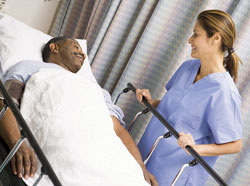 The GW Cancer Institute was awarded more than $6 million in grants that will widen its role in assessing and improving care for cancer patients across the treatment spectrum, from early screening to survivorship.
The GW Cancer Institute was awarded more than $6 million in grants that will widen its role in assessing and improving care for cancer patients across the treatment spectrum, from early screening to survivorship.
The institute announced in late September that it was awarded, in collaboration with the American Cancer Society, a five-year, $4.25 million grant from the federal Centers for Disease Control and Prevention to establish a National Cancer Survivorship Resource Center.
The GWCI and the ACS will work to identify gaps in care, develop criteria for evaluating survivorship programs, and build a web of local and national connections to spread evidence-based resources, all in an effort to better address the needs of the nation's 11 million cancer survivors.
The institute also will host a fellowship program through the national center, which will offer training on improving survivorship specifically in underserved populations.
Separately, the institute announced it will be establishing and coordinating a city-wide Patient Navigation Network through a $2.4 million grant from the D.C. Cancer Consortium.
The network will assist D.C. residents—especially populations for which there are disparities in cancer care—in accessing screening, timely treatment, and support services throughout treatment and into survivorship, regardless of their ability to pay.
The network will include patient navigators at medical centers, hospitals, cancer centers, and community sites around the city.
"You can't ask a woman in Ward 8 to go get a mammogram when she can't get across the Anacostia River without taking five bus rides and two cab rides and losing half a day of her wage account salary," says Steven Patierno, executive director of the GW Cancer Institute. "Patient navigators find creative ways to overcome those barriers."
The District, he says, is a "cancer disaster area."
Susan Lowell Butler, executive director of the D.C. Cancer Consortium, says she believes the D.C. effort will be a "critical step" toward diagnosing cancers sooner and reducing mortalities.

Mr. Safer's Null Space at GW's F Street House. The steel sculpture, inspired by the music of Bach, "reaches out … and manipulates the space around it," says Mr. Safer.
Jessica McConnell
From Null to Infinity
Alumnus and renowned artist John Safer donates a third sculpture to campus, inspired by J.S. Bach.
At the nexus of music and sculpture, artist John Safer sees null space.
That's the name he's given—Null Space—to the tall, twisted, and highly polished steel work, inspired by the music of Johann Sebastian Bach, that now adorns the yard of the F Street House, the Foggy Bottom residence of GW President Steven Knapp.
"I wanted to emphasize that this work, more than most sculptures, not only is a shape that occupies a given space but also reaches out—at least I think it does—and manipulates the space around it," says Mr. Safer, AA '46, BA '47.
The 1979 sculpture, donated this summer and unveiled in a private ceremony in September, was created using "an approach to sculpture which I felt was similar to that of Bach," he says. "I started with a tonic note, then expanded out from that point, creating harmonies and discords, themes and counterpoints, and then eventually returned to the starting point of the tonic note with the hope that I had resolved everything into a harmonious whole.
"I realize that's quite a bit to expect from a motionless piece of metal," he admits, "but that's what I had in mind."
The September unveiling coincided with the opening of an exhibit at GW's Luther W. Brady Art Gallery focusing on 21 of his sculptures.
Though the work of Mr. Safer has been on display the world over—in private and public collections, at embassies and museums, and in award trophies created for the National Air and Space Museum and other organizations—his work is a fixture at GW, as well.
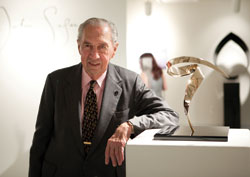
Sculptor John Safer at the Brady Art Gallery, beside a piece called The Dancer and the Dance.
William Atkins
In the rose garden near the University Yard stands a propeller-shaped sculpture, surrounded by an oval, which Mr. Safer dubbed Limits of Infinity III. Mr. Safer's Golden Quill—whose title borrows from the line in Shakespeare's 85th sonnet, "Reserve their character with golden quill"—is in the entrance to Gelman Library. It was created, he says, "with the concept of signifying the majesty and power of Shakespeare's words."
Mr. Safer also plans to donate to the university 40 percent of sales from the Brady Gallery show. "I really don't know of a better cause than education to which anyone could contribute," he says.
It's a sentiment that also has driven his artistic donations to GW, believing that "a university campus should have an aesthetic ambience" as much as a scholarly one.
Speaking at the 2009 GW Commence-ment ceremony, where he received an honorary doctor of fine arts degree, Mr. Safer said: "I tried to create beauty where there had been none before. I tried to create sculptures, which at best, I hoped, would inspire others."
—Menachem Wecker
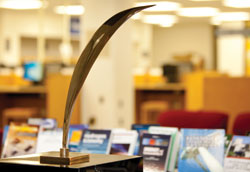
Golden Quill
Jessica McConnell
|
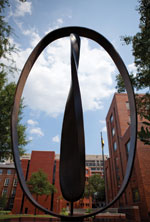
Limits of Infinity III
Jessica McConnell
|
20 Years of GW Magazine
It was fall 1990 and GW Magazine made its debut with a cover story on alumnus Peter Wasilewski and his Antarctic expedition. In 20 years, GW Magazine has taken readers around the world and back.
A lot has changed in the past two decades, with this magazine's founding before the Internet age. In this era of Facebook and Twitter, we still think there's something to be said for sitting down with the printed word, with stories and photographs that allow a deeper look into the university, the world, and the people who make up our community.
This year marks the return of GW Magazine's status as a quarterly publication. To ensure you receive all four editions, please send us an e-mail (magazine@gwu.edu) and ask to be on our quarterly mailing list.
We look forward to the next 20 years.
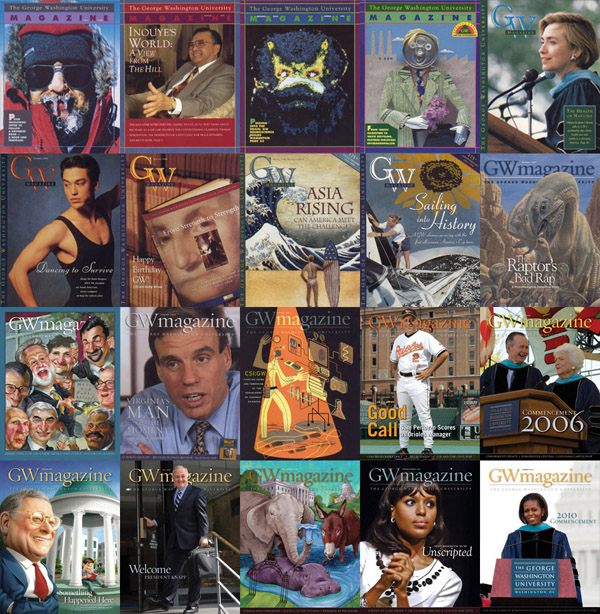
Basketball Teams Prepare to Hit the Court
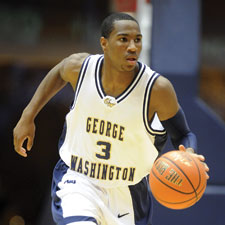
The Colonials will be looking to junior point guard Tony Taylor, one of four returning starters, to lead the offense this season.
GW Sports Information
Armed with more-experienced rosters and a renovated home court, the Colonials men's and women's basketball teams are gearing up for this year's basketball season, which starts in November.
The men's squad, under 10-year Head Coach Karl Hobbs, is set to return four starters—junior point guard Tony Taylor, sophomore shooting guard Lasan Kromah, 6-foot-11 senior center Joseph Katuka, and junior slasher Aaron Ware.
The Colonials (16-15 last season) will be working to fill the void left by graduated forward Damian Hollis, an Atlantic 10 All-Conference honorable mention who last season led the team in scoring (13.9 points per game), rebounding (4.9), free-throw percentage (.839), and blocks (26).
It will be up to Mr. Taylor, who has appeared in all 59 games since his arrival in 2008, to spearhead the Colonials' offense this season. He averaged 9.4 points and 4.2 assists per game last season, and he'll have help from Mr. Kromah, who was selected for last year's Atlantic 10 All-Rookie team. Mr. Kromah emerged last season as one of GW's most consistent scoring threats, averaging 11.8 points per game and converting a team-high 48 three-pointers.
The team has added just three newcomers this year—sharpshooting forwards Chris Fitzgerald, of Swansea, Mass., and Nemanja Mikic, from Serbia; and point guard Dan Guest, of West Hartford, Conn.—as well as new Assistant Coach Donyell Marshall, a 15-year NBA veteran and former star player at University of Connecticut, who replaces Brian Ellerbe.
The women's team is hoping to make lemonade out of last year's lemon of a season (6-22), in which it fought uphill against having the nation's second least-experienced roster and losing three starters to injuries.
Third-year Head Coach Mike Bozeman returns eight players to the court and expects to have his injured trio—senior forward Ivy Abiona, junior forward Tara Booker, and sophomore guard Danni Jackson—back at full strength. Together with junior guard Tiana Myers (12.6 points per game) and junior center Sara Mostafa (10.1 points per game), the fivesome could provide Mr. Bozeman one of the top starting lineups in the conference.
Last season's limited roster did help spread the wealth of experience around the team, with GW leading the nation in minutes played by freshmen. That includes sophomore forward Brooke Wilson, who earned Atlantic 10 All-Rookie team accolades after leading the league's newcomers in rebounding and steals.
The team should be further bolstered by its second straight ESPN Top-50 recruiting class, picking up Chelisa Painter, of Chesapeake, Va.—ESPN's No. 12 ranked power forward—as well as center Erica Chandler, of Charlotte, N.C., and guard Kristin Aldridge, of Mansfield, Texas.
—Brad Bower and Jesse Hooker
Season tickets for both basketball teams are still available, as are memberships to the Colonials Club and the Athletic Director's Club. For more information, call (202) 994-6050 or visit www.GWsports.com.
Renowned Experts in Politics and Media Named SMPA Fellows
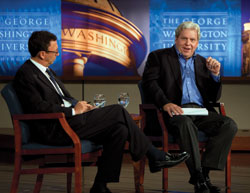 Joe Lockhart
Joe Lockhart Bill Clinton's press secretary, the senior White House correspondent for CNN, and a New York Times columnist have been appointed to serve as fellows in the School of Media and Public Affairs for this academic year.
The appointments of Joe Lockhart, Ed Henry, and Bob Herbert—who as fellows will host events, guest lecture, and meet with students and faculty members—will offer students "an inside view on how our political process and the media actually intersect as they use this fall's election as a real-time case study," says SMPA Director Frank Sesno.
Mr. Lockhart, the former Clinton White House press secretary, is a founding partner and managing director of the Glover Park Group, a strategic communications firm in D.C. He also has served as senior adviser to Sen. John Kerry during his 2004 presidential bid, national press secretary for the 1996 Bill Clinton-Al Gore campaign, deputy press secretary for the 1988 campaign of Michael Dukakis and Lloyd Bentsen, and assistant press secretary for the 1984 Walter Mondale-Geraldine Ferraro campaign.
Mr. Henry, CNN's senior White House correspondent, has conducted sit-down interviews with President Barack Obama in both Beijing and Moscow. Previously, he covered Capitol Hill for CNN and reported from the campaign trail during the 2004 election cycle. Prior to joining CNN in 2004, Mr. Henry was senior editor and columnist for Roll Call. He began his career as an investigative reporter working with the late columnist Jack Anderson. (See Faculty for Writing)
Mr. Herbert specializes in writing about politics, urban affairs, and social trends in his column for The New York Times. He has also worked as a national correspondent for NBC News and as a reporter and editor for the New York Daily News and The Star-Ledger, in Newark, N.J.
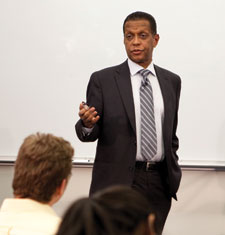
Bob Herbert
|
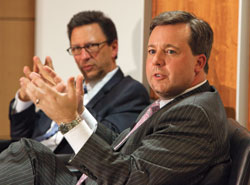
Ed Henry
|
George Welcomes…
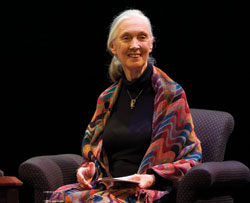
Jane Goodall, renowned primatologist and conservationist, discussed her life and work at GW's Lisner Auditorium Oct. 12. Dr. Goodall answered a range of questions about herself and her career during the event sponsored by the nonprofit Jane Goodall Institute, which both celebrated the 50th anniversary of her pioneering research with chimpanzees and recognized the winners of the institute's Global Leadership Award.
William Atkins
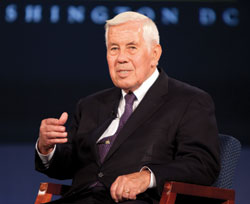
Sen. Richard Lugar (R-Ind.) discussed the threat of weapons of mass destruction Sept. 13 at GW's Jack Morton Auditorium. The ranking member of the U.S. Senate Committee on Foreign Relations is a longtime leader in reducing the threat of nuclear, chemical, and biological weapons. He was a co-founder of the Cooperative Threat Reduction Program, or Nunn-Lugar Program, to destroy weapons of mass destruction in the former Soviet Union.
Jessica McConnell
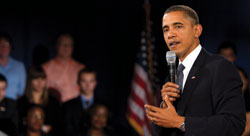
President Barack Obama answered questions in front of 200 people gathered in the Continental Ballroom in GW's Marvin Center Oct. 12 for a "Moving America Forward" town hall meeting. The president took questions from the audience and from individuals across the country using Twitter and Skype. The town hall meeting was sponsored by Organizing for America, a project of the Democratic National Committee.
William Atkins
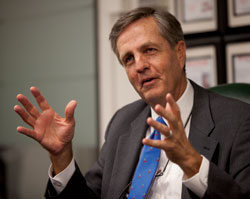
Brit Hume, a political analyst at Fox News, and Professor Mark Feldstein spoke about legendary journalist Jack Anderson at an event at Gelman Library Sept. 14. Both former aides to Mr. Anderson, they helped bring The Jack Anderson Collection to Gelman Library in 2005. The collection, which consists of more than 450 boxes of reporter's notebooks, correspondences, research materials, and story drafts, was opened to the public last June.
Jessica McConnell
|

Jessica McConnell
Health and Human Services Secretary Kathleen Sebelius joined world-class professional athletes, including Olympian gymnast Dominique Dawes (above) and Olympian figure skater Michelle Kwan (below), on campus Sept. 14 to launch a national fitness drive, the latest push in the government's battle against obesity. The initiative seeks to have at least one million people undertake an exercise regimen and earn a Presidential Active Lifestyle Award.

Jessica McConnell
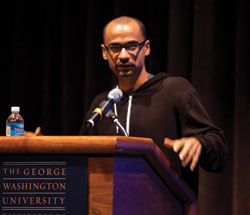
Pulitzer-Prize winning author Junot Diaz visited GW Sept. 17 to kick off the university's month-long Latino Heritage Celebration. Mr. Diaz, who teaches creative writing at MIT, is the author of the books Drown and The Brief Wondrous Life of Oscar Wao, which received the Pulitzer Prize. Mr. Diaz, who was born in the Dominican Republic and raised in New Jersey, explores the lives and struggles of Dominican immigrants in both books.
Jessica McConnell
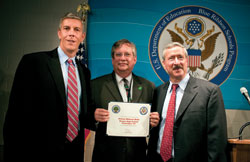
U.S. Secretary of Education Arne Duncan visited School Without Walls, a D.C. Public School on campus that partners with GW, to bestow blue ribbon status on the school. Provost Steve Lerman joined Mr. Duncan Sept. 9 at the event with nearly 100 students in recognition of the partnership between GW and the School Without Walls. Only 304 schools received blue ribbon status of about 95,000 schools nationwide.
William Atkins
|
Teamsters, Jack Anderson Archives Open at Gelman Library
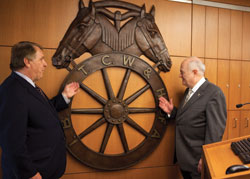
Teamsters General President James P. Hoffa (left) and GW President Steven Knapp discuss a Teamsters emblem that had adorned the union's D.C. headquarters beginning in the late-1950s.
William Atkins
They were formative fixtures of the 20th century: the International Brotherhood of Teamsters and Pulitzer Prize-winning muckraker Jack Anderson, and this fall the Estelle and Melvin Gelman Library opened archival collections from both.
The Teamsters archive opened in October in the library's newly built IBT Labor History Research Center, the first major labor history resource built in the United States in more than three decades. Archivists intend for the center to become a resource on the broader history of labor in the United States.
"There's a tremendous treasure trove of information that is here," said Teamsters General President James P. Hoffa, ranging from the union's modern-day contracts and negotiations to a 1906 booklet outlining a union horseman's pay "for shoeing his horse, for mucking his stall, for putting on the bridle," he said.
The Teamsters archive project began in 2007, when the Teamsters contributed $2 million for GW to establish an archive of its historical materials, making them publicly available for the first time.
The still-growing collection includes a tide of documents (memos, research and legislative files, union publications), thousands of photos, thousands more films and videos, and several hundred audio recordings—spanning a century's-worth of tech platforms. Gelman's new labor archivist, Tom Connors, said it will enable scholars to finally undertake a deep study of how the 1.4 million-member union has evolved since its founding in 1903.
Gelman's Special Collections Research Center also unveiled, in September, a collection of materials from trail-blazing investigative reporter Jack Anderson, who for half-a-century shone a light on government misdeeds and scandals through the widely popular daily column, "Washington Merry-Go-Round."
The collection was donated to the university by Mr. Anderson's family in 2005, the year he died. The next year, the FBI tried to seize the materials, which include Mr. Anderson's notes, correspondence, and research—including classified documents that are required to remain sealed until 2032—as well as materials related to Mr. Anderson's work on TV, radio, and as an author.
GW Professor Mark Feldstein, a former intern to Mr. Anderson, helped bring the collection to the university and plumbs the depths of the reporter's 25-year feud with President Nixon (that led to a plot to assassinate Mr. Anderson) in his new book, Poisoning the Press: Richard Nixon, Jack Anderson, and the Rise of Washington's Scandal Culture. (See Faculty for Writing)
Mr. Anderson "held the lonely banner of investigative reporting aloft in the mid-20th century when no other mainstream journalists dared challenge authorities the way he did," Dr. Feldstein says. "I am delighted that his work can now be shared with journalists, scholars, the public—and even the FBI."
—Danny Freedman
At a Glance
Entrepreneurial Challenge
In the last GW Business Plan Competition, a team of emergency room doctors received $20,000 to launch a start-up that e-mails video discharge instructions to patients when they leave the ER. Next year's competition is coming up—and the stakes are even higher.
The competition, which is open to alumni as well as faculty and students, will be awarding a top prize of $25,000, and three other finalists will win $10,000, $4,000, or $1,000. There's also a $10,000 prize for the best undergraduate team, even if they're already finalists.
The deadline for submissions is Jan. 31, 2011. For entry rules and details, go to http://www.gwbizplan.com.
Class Act
A teen who owns a coin-appraisal business, the first youth delegate to the United Nations, and a nationally ranked table tennis player are among the roughly 2,500 freshmen who arrived on campus this fall.
GW received its highest number of applications ever—21,203—for the 2010-11 academic year, marking a 7 percent increase from last year. The university's acceptance rate was its lowest ever, at 31.5 percent.
"You, the Class of 2014, are the most academically qualified we have ever recruited," President Knapp said at Freshman Convocation. "You arrive at—and you powerfully symbolize—a time when this university is moving boldly to achieve and solidify the world-class stature that befits the largest university in this great international city."
Toxic Avenger
Lynn Goldman, dean of the School of Public Health and Health Services, is being honored in November for her work to protect children from toxic chemicals.
Dr. Goldman, a pediatrician and epidemiologist, is one of nine recipients of a Heinz Award this year, which carries a $100,000 prize and is given to individuals who are addressing the impacts of human activities and natural processes on the environment.
Teresa Heinz, chairman of the Heinz Family Philanthropies, says that "Several hazardous pesticides have been removed or restricted thanks to Dr. Goldman," who came to GW this year from Johns Hopkins University, and previously was assistant administrator for the U.S. Environmental Protection Agency's Office of Prevention, Pesticides and Toxic Substances.
Gifted and Talented
The U.S. Department of Education has designated the Elliott School's Institute for Middle East Studies as a National Resource Center, an honor that carries a $1 million grant to advance the research and teaching of the institute.
The grant, spread over four years, will allow IMES to develop its Arabic, Persian, and Turkish language programs, to boost funding for the Middle East and North Africa Resource Center, housed at Gelman Library, and to bolster the newly launched Project on Middle East Political Science. The funds also will help GW launch an outreach initiative for Iraq War veterans, and training programs for journalists and primary and secondary school teachers.
 Mapping the Battle Lines
Mapping the Battle Lines
The venerable GW Battleground Poll added a new partner, Politico, and once again set out to gauge the temperature of voters in a fiercely contentious election season.
The renamed Politico-George Washington University Battleground Poll received widespread attention for its first three sets of findings (available at www.politico.com and www.gwu.edu), released in September and October. Three additional surveys are planned for 2011.
The unique, bipartisan poll is conducted and analyzed by Republican pollster Ed Goeas, of The Tarrance Group, and Democratic pollster Celinda Lake, of Lake Research Partners.
On campus, the partnership is led by the GW Global Media Institute, affiliated with both the Graduate School of Political Management and the School of Media and Public Affairs.
Digging History
The GW Capitol Archaeological Institute was launched in October, and will draw from expertise at the university and the world-class resources "in our own backyard," says Eric Cline, chair of the Department of Classical and Near Eastern Languages and Civilizations, who is the institute's director.
Housed in GW's Columbian College of Arts and Sciences, the institute's plans include creating a speaker series, organizing tours to excavation sites, creating programs to examine the role of cultural heritage in sustainable development, and promoting "green" archaeology through the use of new technology at digs.
The institute was made possible through a gift from Deborah Lehr, MA '89, and John F.W. Rogers, BA '78.
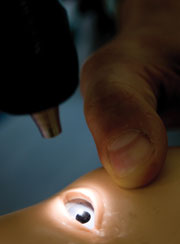
Jessica McConnell
Hands-on Learning
They blink, they bleed, they speak 20 languages. They're robots in the GW School of Nursing's new simulation lab at the Virginia Science and Technology Campus in Ashburn, Va.
The lab, an invaluable resource for nurses-in-training, recently benefited from a gift of $23,000 from Reston Hospital Center and the Hospital Corporation of America Virginia Health System, which allowed the School of Nursing to purchase extra equipment to help simulate a clinical environment around the dummies.
"As Reston Hospital Center continues to grow, it is more important than ever to have competent nurses to care for our community," said Cindy Glover, chief nursing officer at RHC. "GW is such a prestigious school, and I'm dying for your students to come work here."


 Probing deeper into the mysteries of the brain—how it's built, how it works as a cohesive unit, and how that gets distorted by disease—will be the work of the university's new Institute for Neuroscience, which launched over the summer.
Probing deeper into the mysteries of the brain—how it's built, how it works as a cohesive unit, and how that gets distorted by disease—will be the work of the university's new Institute for Neuroscience, which launched over the summer.


 Obese women: $4,879
Obese women: $4,879
 The GW Cancer Institute was awarded more than $6 million in grants that will widen its role in assessing and improving care for cancer patients across the treatment spectrum, from early screening to survivorship.
The GW Cancer Institute was awarded more than $6 million in grants that will widen its role in assessing and improving care for cancer patients across the treatment spectrum, from early screening to survivorship.

















 Mapping the Battle Lines
Mapping the Battle Lines